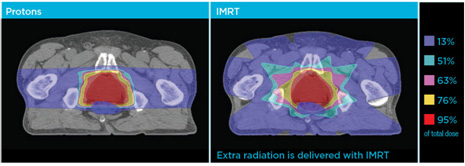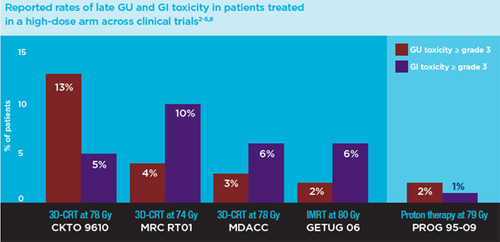Myth #3: Proton therapy is no better than advanced forms of conventional photon (X-ray) radiation treatment, such as IMRT, IGRT, CyberKnife, TomoTherapy or RapidArc. And, there may be more rectal damage with proton.
The Physics
Let’s start out with the physics of radiation therapy. Proton radiation and conventional photon (X-ray) radiation destroy cancer the exact same way: by stripping electrons orbiting around the nucleus of atoms that are part of the molecules that make up the tissues in the body. This causes damage to the genetic material, or DNA of cancer cells ultimately causing their death or eliminating their ability to proliferate. Without healthy DNA the cancer cells can no longer function properly or repair themselves, leading to apoptosis—or programmed cell—death. So radiation—proton or photon—programs cancer cells to die. If you deliver enough radiation to the tumor, all the cancer cells will die.
Radiation to Healthy Tissue
All scientists, radiation oncologists, and urologists agree that the only safe dose of radiation to healthy tissue is a zero dose. They would also agree that the difference between protons and photons (X-rays), which are used in IMRT and other forms of external beam radiation therapy, is clear cut: X-rays radiate everything in their path on their way to the tumor and also on their way out of the body. X-rays don’t stop doing damage until they run out of energy.
Protons, on the other hand, can be controlled in such a way that they release minimal energy on their way to a tumor and can be brought to a stop at the tumor site, thus releasing virtually no radiation beyond the tumor, and preserving healthy tissue outside of the target area. So, with photons (X-rays), such as in IMRT treatment, not only is the tumor damaged, so is much of the healthy tissue surrounding the tumor. With protons, almost all of the energy is deposited right at the tumor site. So with proton, healthy tissue is mostly spared.
A Choice: Destroy the House or the Whole Neighborhood
In Bob Marckini's book, You Can Beat Prostate Cancer: And You Don't Need Surgery To Do It, he compares photon radiation (X-rays, IMRT) to military “carpet bombs,” which destroy whole neighborhoods, versus proton, which is like a computer guided “smart bomb” that just destroys the target, leaving the neighborhood intact.
Now consider where the prostate is located in the male anatomy, and what’s in the “neighborhood.” The prostate is deep inside the lower torso. The urethra passes through it; the rectum is right next to it; the bladder is just above it, and the penis and testicles are also in the same “neighborhood.” Which would you prefer to attack cancer in the prostate, a “smart bomb” or a “carpet bomb?”
According to the Prostate Cancer Communication Newsletter, PAACT Vol. 23 Number 1, IMRT delivers three to five times more radiation to healthy tissue than proton.
The image below shows the difference between proton therapy on the left, and IMRT on the right. As you can see, with IMRT the entire lower torso is radiated, and, brighter colors around the prostate target show high levels of radiation outside the target.

Higher Doses Better Outcomes—Maybe
Because protons spare surrounding healthy tissue, the dose can be increased without doing collateral damage. With IMRT, it’s a balancing act, because in order to deliver higher doses of radiation to the tumor, you are also delivering higher radiation doses to healthy tissue. This increases the likelihood of side effects and secondary cancers later in life. We will discuss this subject in more detail in the truth about myth #8.
The bar chart below shows the difference in genitourinary (GU) and gastrointestinal (GI) toxicity for conformal external beam radiation therapy (CRT), IMRT, and proton. Note that while the best form of X-ray therapy is comparable to proton with regard to GU toxicity, it shows six times the GI toxicity (6% vs. 1%).

Patient Reported Results Show Proton’s Superiority
Our group, the Brotherhood of the Balloon, represents more than half the men alive today who have been treated with protons for prostate cancer. Two separate surveys of our membership have shown the superiority of proton therapy. When we discuss Myth #7 we will cover these surveys in some detail.
What About Cure Rates?
Numerous studies at several proton treatment centers have shown outstanding results. For low and intermediate risk patients, the disease-free survival rate with proton is in the range of 97 – 99% at five years and 93 – 94% at ten years. Patients with advanced disease had lower rates, but still comparable to, or better than, those of other modalities. More information on this will follow when we discuss Myth #7.
Why Not Randomized Clinical Trials (RCTs) Comparing Proton to IMRT?
Some insurers have denied coverage for proton therapy for prostate cancer because there have never been randomized clinical trials comparing the proton therapy to IMRT, which is cheaper. Remember, we disproved this myth last month by pointing out that initial cost may be higher, but long term costs for proton are likely comparable or lower. And even initial treatment costs will be comparable when the shorter treatment protocols are adopted sometime in the future.
But those who call for RCTs today are ignoring some important points including:
- There are ethical issues involved in the patient selection process. Half the group will be intentionally given higher doses of radiation to healthy tissue. Physicians who understand the physics of proton therapy have difficulty participating in such a study.
- An RCT program has been funded, but physicians/researchers are having a difficult time recruiting men to participate. Once the differences between proton and IMRT are explained to them, and they learn they may be randomly assigned to the treatment option that will deposit greater amounts of radiation to healthy tissue, they refuse to participate.
- It will take five to ten years to fully understand disease free survival and morbidity (side effects) from the trial. By that time the lower-cost proton protocol will be standard practice and the cost debate will disappear.
One last point: There have never been randomized clinical trials comparing any prostate cancer treatment modalities. So, no one can say for sure how surgery compares with external beam radiation, or how seeds compare with IMRT, or how open surgery compares to da Vinci laparoscopic robotic surgery. And, if you really want to complicate things, bring in RapidArc, CyberKnife, TomoTherapy, HIFU, and other modalities. So why single out proton therapy?
Why Spend $200 Million if IMRT is Just as Good?
When Bob Marckini was treated in 2000, there was only one proton center operating in the U.S., Loma Linda University Medical Center. Today there are ten proton centers in the U.S. with 10 more under construction and nine more in the planning stage. Soon there will be 31 proton centers in the U.S. with many more around the world.
Would hospitals and investors be willing to spend close to $200 million to build a proton center if proton was no better than IMRT?
Summary
The bottom line is this: During the past 22 years, thousands of prostate cancer patients have been treated with protons and numerous studies have been published showing high cure rates and minimal side effects. The laws of physics show, unequivocally, that proton is superior to IMRT and all other forms of photon (X-ray) radiation because significantly less radiation is deposited on healthy tissue. The likelihood of secondary cancers with proton is essentially zero.
All the data, all the patient testimonials, and all the surveys show that proton therapy cures cancer at least as well as any of the alternatives; it’s painless and non-invasive; and it leaves the patient with a higher quality of life than any of the other options. In our 2009 survey of BOB members, 97% of the respondents reported the quality of their lives after treatment was the same as or better than before treatment.
And finally, there are groups with names like, FloridaBOBs, ProtonPals, Brotherhood of the Balloon and others consisting of men who were treated with proton therapy for prostate cancer. The thousands of men in these groups are grateful for their treatment; and they spend their time promoting proton therapy in their communities. Where else can you find a prostate cancer treatment modality that has a fan club? You won’t find a bunch of radical prostatectomy patients banding together to promote the benefits of surgery, or a group of IMRT guys or brachytherapy patients encouraging their friends and family to go the route they have chosen. There can only be one reason for this. Proton therapy is far superior, and those of us who have been fortunate enough to have received proton therapy know this, and we want to tell the world about it.
Myth #3: BUSTED!
Any questions? Just ask.
